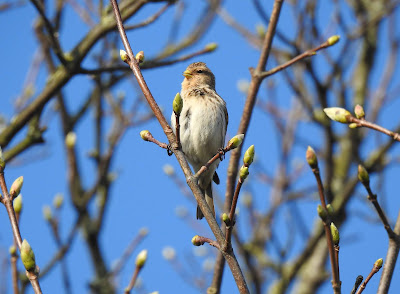At first light under 1 okta cloud cover with a 5 mph northeasterly wind I was at the pools checking how flooded our net rides were. I could get into the reeds and Willow scrub okay, but there was some flooding in the net rides themselves. We generally just put up three nets at this site, two 60 foot nets and one 40 foot net, but this morning it would only have been possible to put up three 20 foot nets, as the reedbed end of all the rides was quite flooded. However, I did think that if we have another week of dry weather, it might be possible to do some ringing here next weekend. Fingers crossed!
Sunrise over one of our flooded net rides
It never ceases to amaze me how Cetti's Warblers have colonised all the wetlands at the Obs in recent years and just this one wetland area had five singing males this morning. The only other warblers I had here were two singing Chiffchaffs.
The pools were quiet in terms of a wildfowl, obviously because of the time of year, but also because females will be on the nest, so 17 Tufted Ducks, a male Gadwall and a pair of Shovelers was noteworthy. After the ubiquitous Raven and a male Wheatear, it was time to have a look in the cemetery.
As soon as I got out of my car I could hear a glorious sound, the sound of a singing Willow Warbler; Spring has sprung! I moved on to the coastal park and was greeted with three singing Willow Warblers here, and a singing Blackcap!
There was quite a lot of vis this morning, particularly Meadow Pipits, even though I wasn't in a particularly good place to count them I could see streams of Meadow Pipits heading northeast out over Morecambe Bay. I recorded 246 in my notebook, but there was probably at least four or five times this number.
Siskins were also going over, often just heard and not seen! Some would drop into the tops of the conifers and Sycamores and then continue heading east. My notebook records eleven, but again there was a good deal more.
A female Brambling and a Goldcrest were the last of what I would call grounded migrants that made it into my notebook.
Twite were the main interest here and Ian had phoned my whilst I was in the cemetery to say that he had 28 Twites in the tree tops in the coastal park, a first record for the site. When I was later at the site stood on top of the mound watching and counting some of the vis, the Twite appeared and whipped over the top of my head into the Sycamores. I walked round and located 28 birds calling away to each other from the tree tops! It's not often that you see Twite in trees. They were also dropping down and feeding on the amenity grassland within the park and were obviously able to find some food.
Tree top Twites above and below
Over on the right you will see that I have updated the ringing totals for Fylde Ringing Group up until the end of March. During the month five new species were ringed for the year and these were Meadow Pipit, Brambling, Treecreeper, Greenfinch and Reed Bunting.
below you will find the top nine 'movers and shakers' for the year and the top three species ringed for the month.
Top Nine Movers and Shakers
1. Linnet - 67 (same position)
2. Goldfinch - 65 (same position)
3. Blue Tit - 25 (same position)
4. Lesser Redpoll - 21 (straight in)
5. Chaffinch - 20 (same position)
6. Great Tit - 15 (down from 4th)
7. Goldcrest - 13 (straight in)
Siskin - 13 (straight in)
9. Coal Tit - 10 (straight in)
Top Three Ringed in March
1. Lesser Redpoll - 19
2. Goldfinch - 12
3. Goldcrest - 11





No comments:
Post a Comment